| a | b | c | d | e | f | g | h | ||
| 1 |
| 1 | |||||||
| 2 | 2 | ||||||||
| 3 | 3 | ||||||||
| 4 | 4 | ||||||||
| 5 | 5 | ||||||||
| 6 | 6 | ||||||||
| 7 | 7 | ||||||||
| 8 | 8 | ||||||||
|
a |
b |
c |
d |
e |
f |
g |
h |
||
Rules
Mind that UCThello has an option menu, too. Selection of specific options might alter the basic rules described as follows. Besides rule options you can find additional options like showing or alternatively hiding markers on available fields a player is allowed to set own game pieces on own turn. Please make sure the current game options are chosen as intended by both players prior to game start.
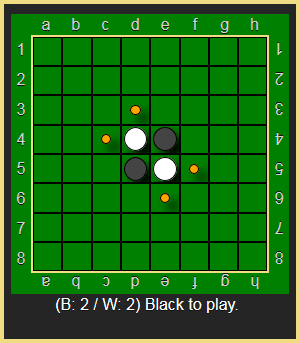
The game is played in turns by two players namely Black and White. Starting position shows pieces on the central four fields. Initially Black's pieces are on d5 and e4 (near-left-to-far-right diagonal) while White's pieces are on e5 and d4 (near-right-to-far-left diagonal). Initial player is Black.
A player's turn consists in
- setting a game piece of own color on an allowed field followed by
- flipping specific pieces from opponent's color into own color by replacing these according to the rules.
The action of placing a game piece onto a vacant field is called a set. A player must pass his turn if no set is available.
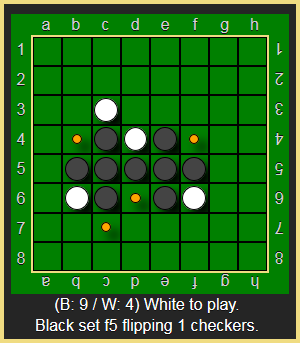
Setting a game piece of own color on an empty vacant field is considered legal or allowed if in at least one direction (horizontally, vertically, diagonally) exactly this game piece and another piece of own color already on board surrounds game pieces of opponent's color in an unbroken row. Such that two own game pieces form a bracket around the opponent's unbroken row of game pieces. If such bracketing by the newly set game piece takes place in multiple directions at once then flipping the opponent's pieces into own game pieces is performed in all these affected directions.
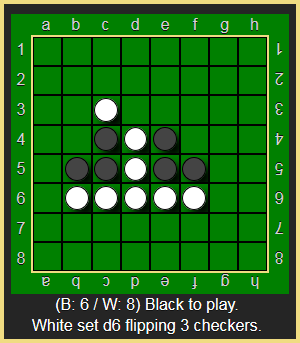
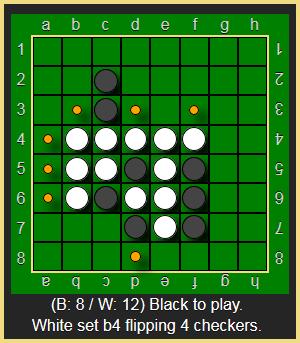
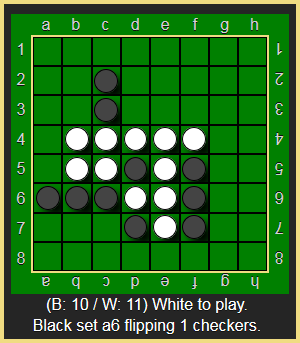
Game is over if either both players must pass with no available sets left or if there is no remaining empty field on the board. The player having the most pieces of own color on the board does win the game then.
Proposal is to offer a revanche or revenge match by the winner. As an option the weaker opponent might choose the game options for the next round.
Have fun and enjoy the game…
Legal

Copyright (c) 2016, 2023
@author Oliver Merkel, Merkel(dot) Oliver(at) web(dot) de.
All rights reserved.
Logos, brands, and trademarks belong to their respective owners.
All source code also including code parts written in HMTL, Javascript, CSS is under MIT License.
The MIT License (MIT)
Copyright (c) 2016, 2023 Oliver Merkel, Merkel(dot) Oliver(at) web(dot)de
Permission is hereby granted, free of charge, to any person obtaining a copy of this software and associated documentation files (the "Software"), to deal in the Software without restriction, including without limitation the rights to use, copy, modify, merge, publish, distribute, sublicense, and/or sell copies of the Software, and to permit persons to whom the Software is furnished to do so, subject to the following conditions:
The above copyright notice and this permission notice shall be included in all copies or substantial portions of the Software.
THE SOFTWARE IS PROVIDED "AS IS", WITHOUT WARRANTY OF ANY KIND, EXPRESS OR IMPLIED, INCLUDING BUT NOT LIMITED TO THE WARRANTIES OF MERCHANTABILITY, FITNESS FOR A PARTICULAR PURPOSE AND NONINFRINGEMENT. IN NO EVENT SHALL THE AUTHORS OR COPYRIGHT HOLDERS BE LIABLE FOR ANY CLAIM, DAMAGES OR OTHER LIABILITY, WHETHER IN AN ACTION OF CONTRACT, TORT OR OTHERWISE, ARISING FROM, OUT OF OR IN CONNECTION WITH THE SOFTWARE OR THE USE OR OTHER DEALINGS IN THE SOFTWARE.
If not otherwise stated all graphics (independent of its format) are licensed under
![]()
Images are licensed under a
Creative Commons Attribution-NonCommercial-ShareAlike 4.0
International License.
UCThello Principles and Concepts
UCThello implements a two-player deterministic board game.
UCThello is a board game using Monte-Carlo Tree Search (MCTS) with UCB (Upper Confidence Bounds) applied to trees (UCT in short) for the computer player AI. The board game used for demonstration purposes of the UCT algorithm is close to a game named Othello depending on selected options. In fact it can be played depending on your configuration following the official tournament rules of the WOF - World Othello Federation - if intended. Other rule settings to play variants are available, too.
The basic concept of performing a player's turn like in UCThello can be found in 19th century board games or possibly earlier like in Annex, The game of Annexation, Reversi and quite modern successors like Othello or variants like the two-or-more player game Rolit. Depending on the reference one might find contradicting creators for the basic concept and idea of flipping multicolored game pieces initiated by setting a game piece of own color following a bracketting rule. Unsure but often cited for Reversi you will find Lewis Waterman or John W. Mollett. So a specific underlying game mechanics belongs to the public domain due to its age and unknown creator. For own creations mind that trademarks do exist for some of the games or possibly patents might exist for technical/mechanical implementations.
Third Party Code Licenses
This UCThello implementation uses unmodified independent code libraries provided by third parties. Since their licenses might vary the corresponding information is externally linked below. Thus these external links will enable you to reproduce any copyright notice, any related list of conditions, disclaimers, and especially the copyright holders and authors of the corresponding third party functionality.